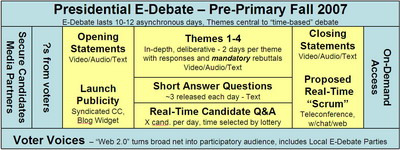In early January, we announced that we made it to round two of the Knight Foundation’s New Challenge with our proposal for a Pre-Primary Presidential E-Debate. We hosted the first e-debate back in 1994.
We will find out if our proposal wins funding in mid-April. Ultimately, our goal is to see this idea take off, so here is our top secret e-debate diagram to spur collaboration among a network of hosts:
You like it? Watch our 20 minute “screencast” with details as prepared for the Knight Foundation. Perhaps you might like to support the idea yourself?
Whether we are funded or not, you can help make a signature online debate – based the voter’s perspective – happen by signing our e-petition to the major candidates (Republican, Democratic pre-primary and for the general, others). Then ask your friends to sign it. I’d say about one million of us ought to do the trick.
We will keep those who sign the petition informed of any major e-debates that emerge this election cycle. If you are a candidate for President, feel free to drop us an e-mail noting your interest in participating pending the full rules and dates. 🙂
Steven Clift
E-Democracy.Org
P.S. The day after we shared our News Challenge announcement, Reuters reported that the Huffington Post was exploring something (a non-partisan e-debate will need Republicans) and last week Gather.com entered the fray (welcome!) proposing a general election exchange (having worked on the previous Web White and Blue presidential e-debate in 2000, at this late point the candidates are completely scripted, so I recommend that is only worth doing as part two following a pre-primary experience). Even YouTube is getting into the act with YouChoose where candidates can upload videos and you can comment. Our experience is that in addition to candidate driven use of “interactivity” a single two week e-debate “candidate stage” syndicated (think simulcast like with television debates) across dozens of websites with citizen questions coming into a central is the best way to get all of the candidates on board and to engage the broadest audience. We also propose turning the full “Web 2.0” Internet into a participation zone we call Voters Voices based on our 2006 experience in Minnesota.
